Convergent & divergent evolution in Animalia
Biology 112, Diversity of Life
StFX Biology department, May 17th, 2021
Jesse McNichol, Postdoc, University of Southern California

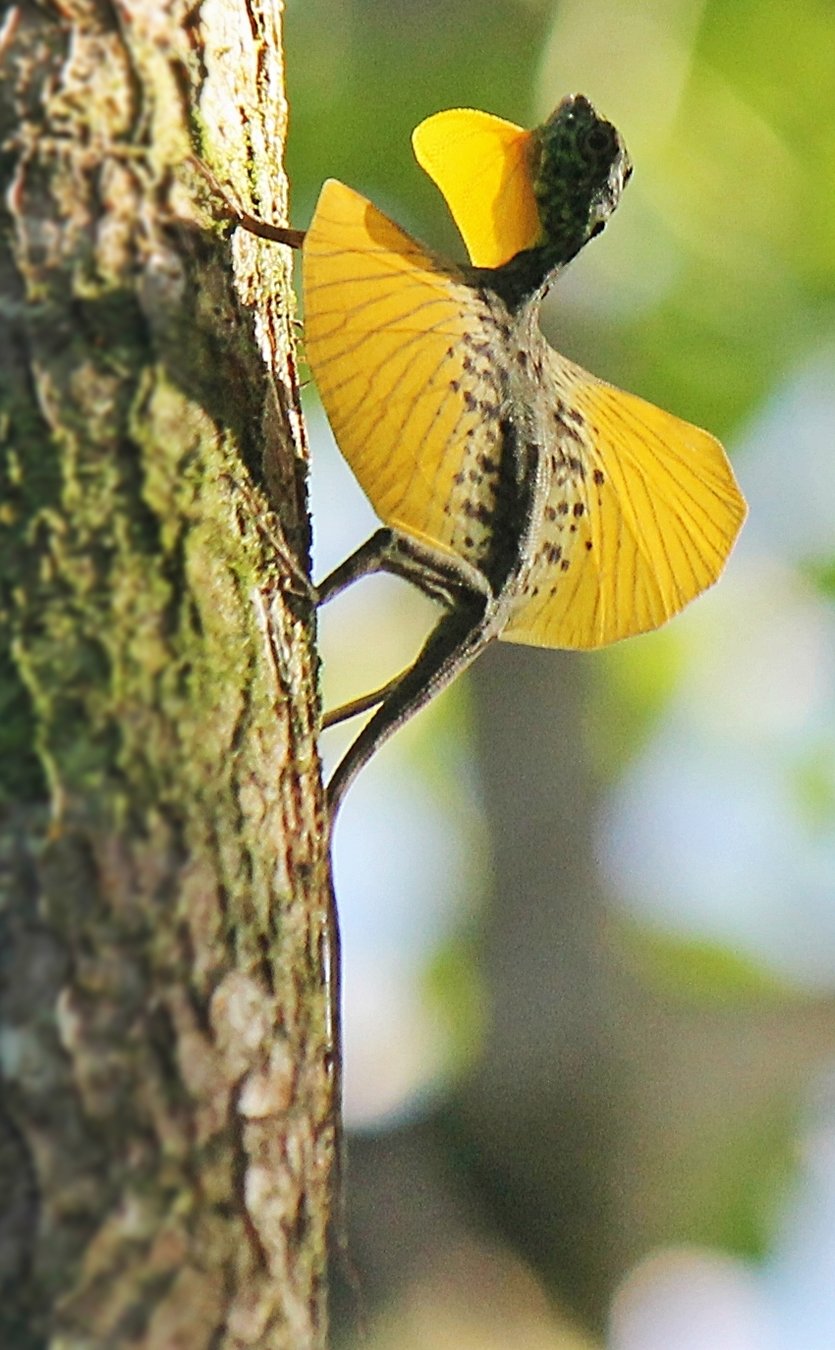
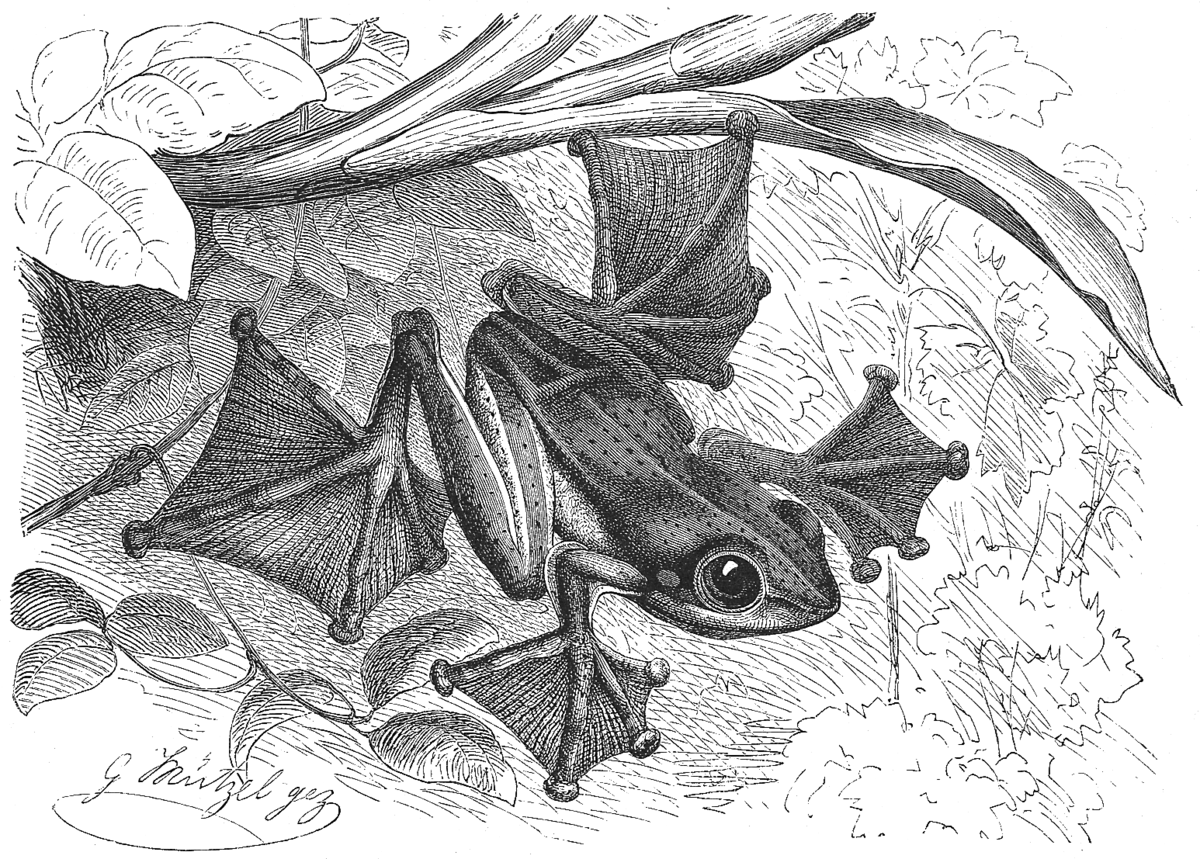

Roadmap
- What is divergent evolution? What is a common ancestor, and what are ancestral / derived traits?
- What drives divergent evolution?
- What is convergent evolution, and what drives it?
- What are similarities and differences compared with divergent evolution?
- How do developmental constraints affect convergent evolution?
- How would you prove that convergent or divergent evolution is happening?
- Clicker questions
- Group discussion and worksheet at end of class
Roadmap
- What is divergent evolution? What is a common ancestor, and what are ancestral / derived traits?
- What drives divergent evolution?
- What is convergent evolution, and what drives it?
- What are similarities and differences compared with divergent evolution?
- How do developmental constraints affect convergent evolution?
- How would you prove that convergent or divergent evolution is happening?
Divergence from common ancestor

Divergence from what?

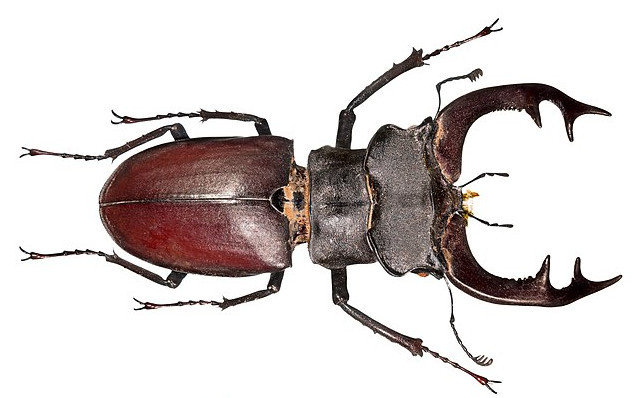
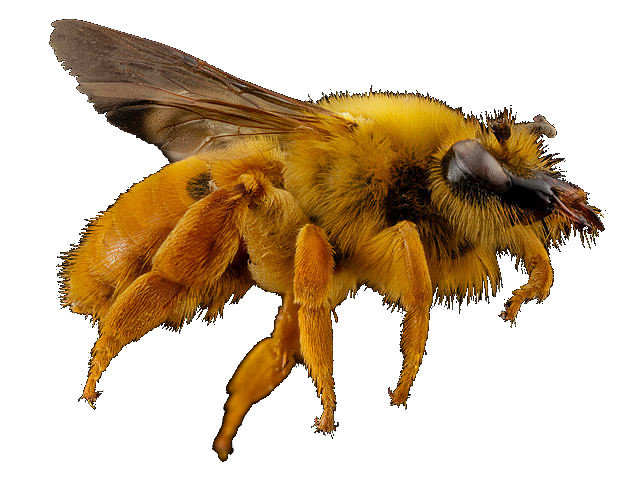
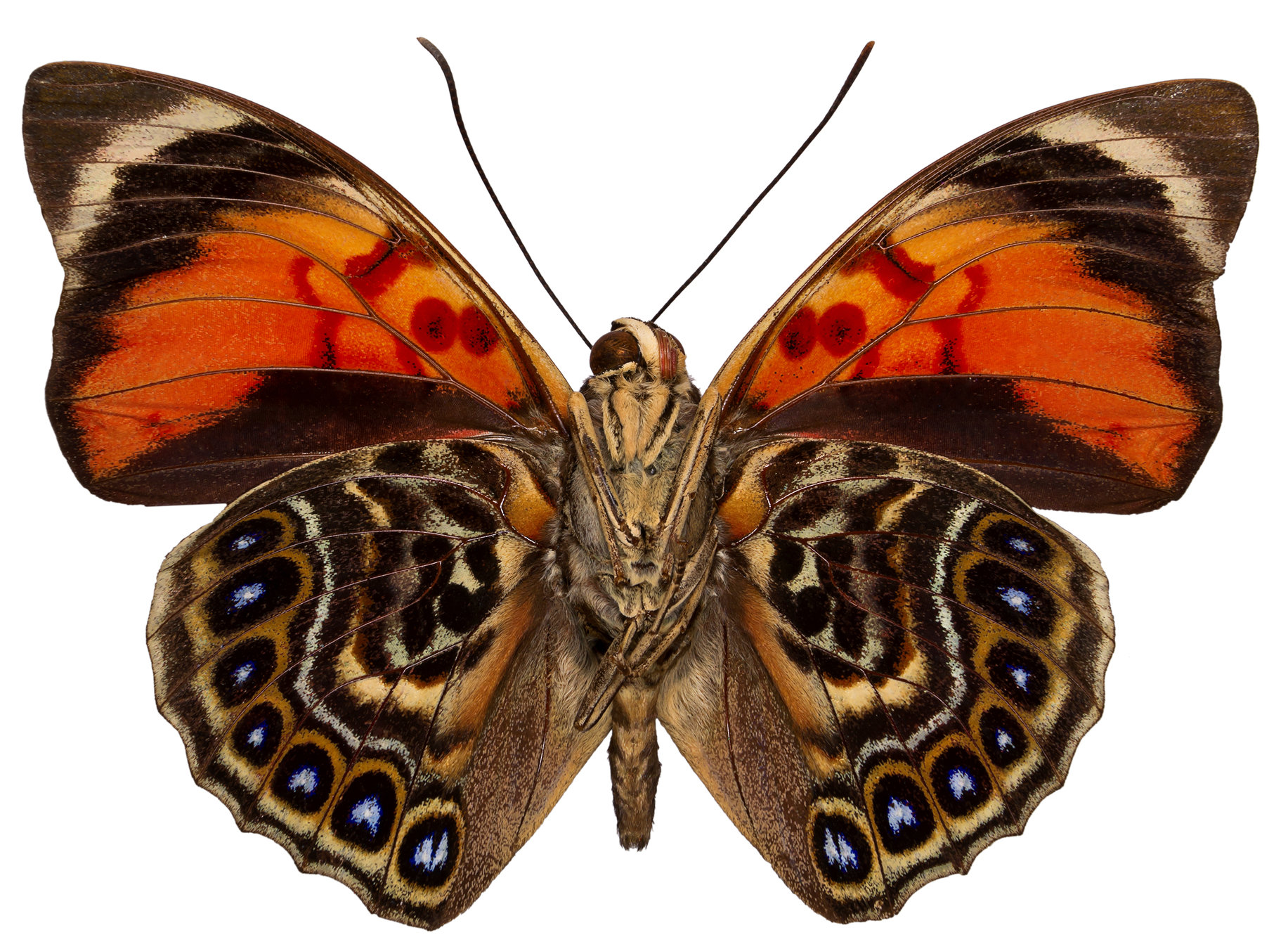
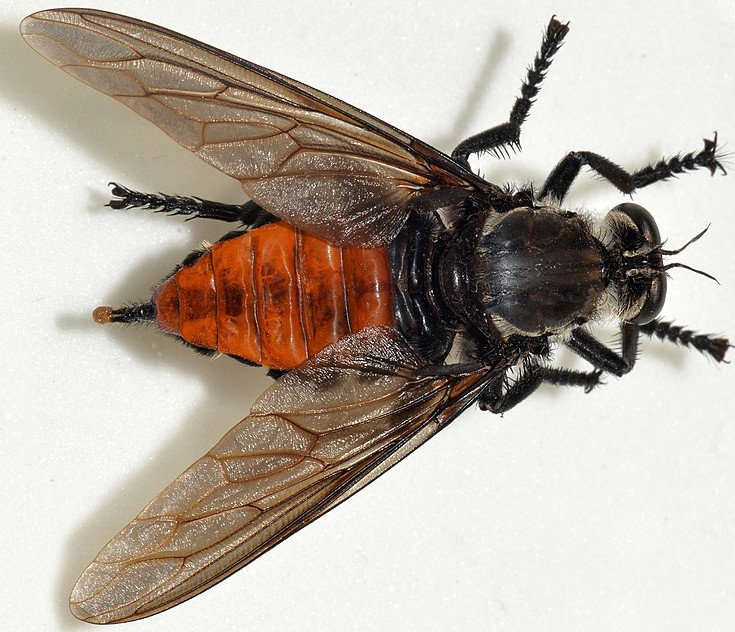

Universal common ancestor
Traits change after divergence
Traits present in common ancestor = ancestral traits






Newly evolved traits in descendants (e.g. social behaviour) = derived traits

Which is true about divergent evolution?
1) Ancestral traits are only found in the common ancestor.
2) Divergent evolution leads to new, derived traits in descendants.
3) The common ancestor is extinct, or has evolved into something else.






D) 2 & 3
E) 1 & 3
C) 2
B) 1 & 2
A) All of the above
Which is true about divergent evolution?

Which is true about divergent evolution?
1) Ancestral traits are only found in the common ancestor.
2) Divergent evolution leads to new, derived traits in descendants.
3) The common ancestor is extinct, or has evolved into something else.






D) 2 & 3
E) 1 & 3
C) 2
B) 1 & 2
A) All of the above
Roadmap
- What is divergent evolution? What is a common ancestor, and what are ancestral / derived traits?
- What drives divergent evolution?
- What is convergent evolution, and what drives it?
- What are similarities and differences compared with divergent evolution?
- How do developmental constraints affect convergent evolution?
- How would you prove that convergent or divergent evolution is happening?
What drives divergence?
- Natural selection drives adaptation to new environment
- Environmental constraints lead to different adaptations (e.g. herbivory in kangaroos)
Opportunity causes "adaptive radiation" from CA
Roadmap
- What is divergent evolution? What is a common ancestor, and what are ancestral / derived traits?
- What drives divergent evolution?
- What is convergent evolution, and what drives it?
- What are similarities and differences compared with divergent evolution?
- How do developmental constraints affect convergent evolution?
- How would you prove that convergent or divergent evolution is happening?
Is convergence the mirror image of divergence?

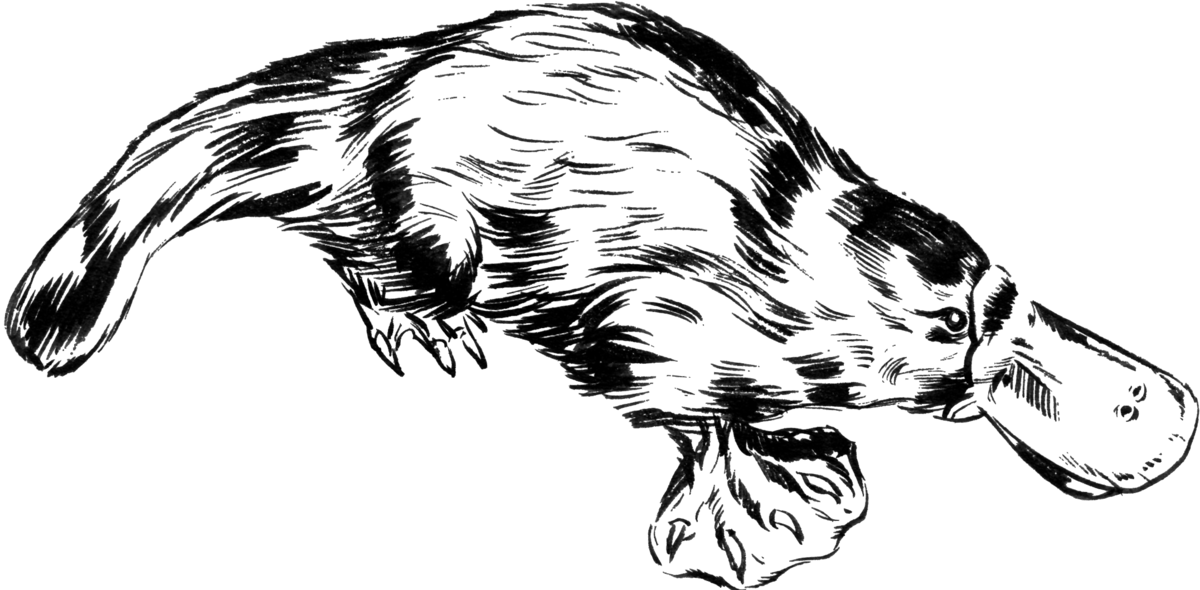
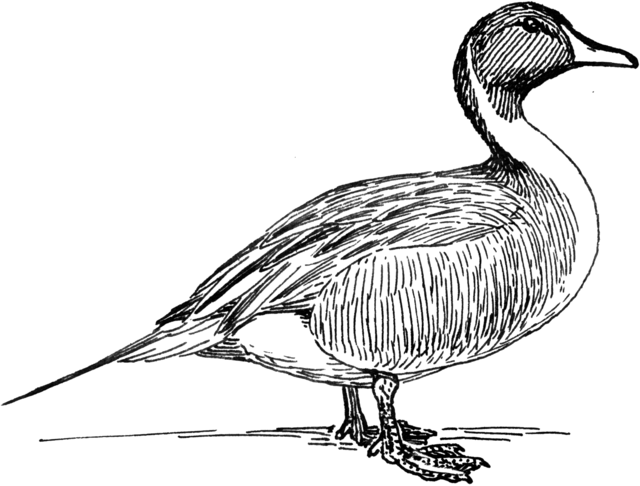
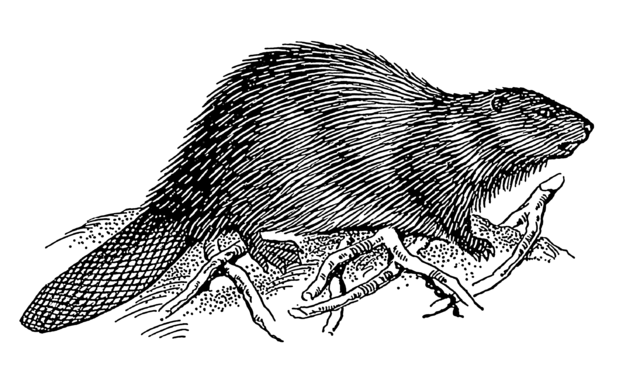
?

Divergence and convergence not mirror images
- "Species diverge, traits converge"
-
Response to similar environmental constraint, driven by natural selection
- Common ancestor lacks this trait




Roadmap
- What is divergent evolution? What is a common ancestor, and what are ancestral / derived traits?
- What drives divergent evolution?
- What is convergent evolution, and what drives it?
- What are similarities and differences compared with divergent evolution?
- How do developmental constraints affect convergent evolution?
- How would you prove that convergent or divergent evolution is happening?

Similarities and differences
Which of the following is not true about convergent evolution and divergent evolution?
A) Divergence occurs at the whole genome level, whereas convergence can occur at the level of a single trait.
B) Convergent evolution causes distantly-related species to become more similar, while divergent evolution often causes relatives to become more dissimilar.
C) Divergent evolution is driven by natural selection, while convergent evolution is driven by the environment.
D) Both involve adaptations that increase fitness.
Similarities and differences

Similarities and differences
Which of the following is not true about convergent evolution and divergent evolution?
A) Divergence occurs at the whole genome level, whereas convergence can occur at the level of a single trait.
B) Convergent evolution causes distantly-related species to become more similar, while divergent evolution often causes relatives to become more dissimilar.
C) Divergent evolution is driven by natural selection, while convergent evolution is driven by the environment.
D) Both involve adaptations that increase fitness.
Roadmap
- What is divergent evolution? What is a common ancestor, and what are ancestral / derived traits?
- What drives divergent evolution?
- What is convergent evolution, and what drives it?
- What are similarities and differences compared with divergent evolution?
- How do developmental constraints affect convergent evolution?
- How would you prove that convergent or divergent evolution is happening?
Developmental constraints
-
Developmental process : single cell => animal
- Constrains the way traits develop

Developmental constraints



Stretched skin
Stretched toes
Stretched ribs (!)

Developmental constraints
Within reptiles and lizards, there have been many examples of gliding species with stretched ribs, but never with stretched skin or toes. This shows that:
A) Gliding is an ancestral trait shared by reptiles / lizards.
C) Webbed feet and stretched skin are developmentally impossible for reptiles / lizards.
B) Their developmental process favours this type of adaptation.
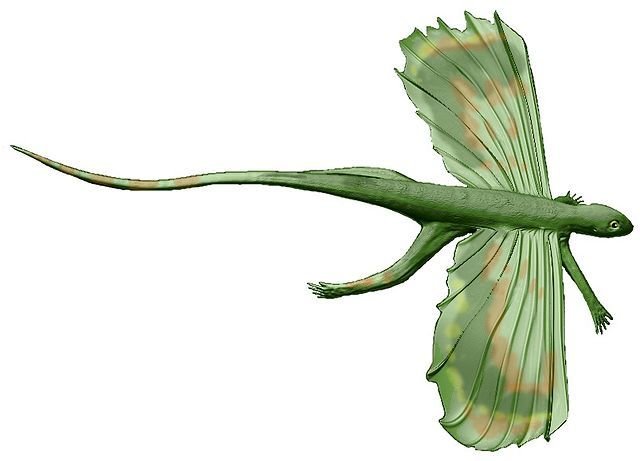
Icarosaurus siefkeri
D) Reptiles and lizards used the same genes for gliding flight.
Developmental constraints

Developmental constraints
Within reptiles and lizards, there have been many examples of gliding species with stretched ribs, but never with stretched skin or toes. This shows that:
A) Gliding is an ancestral trait shared by reptiles / lizards.
C) Webbed feet and stretched skin are developmentally impossible for reptiles / lizards.
B) Their developmental process favours this type of adaptation.

Icarosaurus siefkeri
D) Reptiles and lizards used the same genes for gliding flight.
Roadmap
- What is divergent evolution? What is a common ancestor, and what are ancestral / derived traits?
- What drives divergent evolution?
- What is convergent evolution, and what drives it?
- What are similarities and differences compared with divergent evolution?
- How do developmental constraints affect convergent evolution?
- How would you prove that convergent or divergent evolution is happening?
Discussion activity
- Get into usual groups of 3-4, discuss for 15 minutes
- Fill out worksheets and hand in at the end of class
- Reminders for when to record answers, move on
-
Circulate around class to listen in on discussion, clarify, participate
- Use these responses at end of class when reviewing examples of acceptable answers


Traits change after divergence
Traits present in common ancestor = ancestral traits






Newly evolved traits in descendants (e.g. social behaviour) = derived traits
Discussion activity 1/2 : Divergence
-
You are a palaeontologist ("fossil hunter") studying the evolution of a group of related dinosaurs. How can you find evidence of divergent evolution?
- What kind of fossil materials do you need?
- What information do these fossils tell you?
- How would you identify a likely common ancestor?
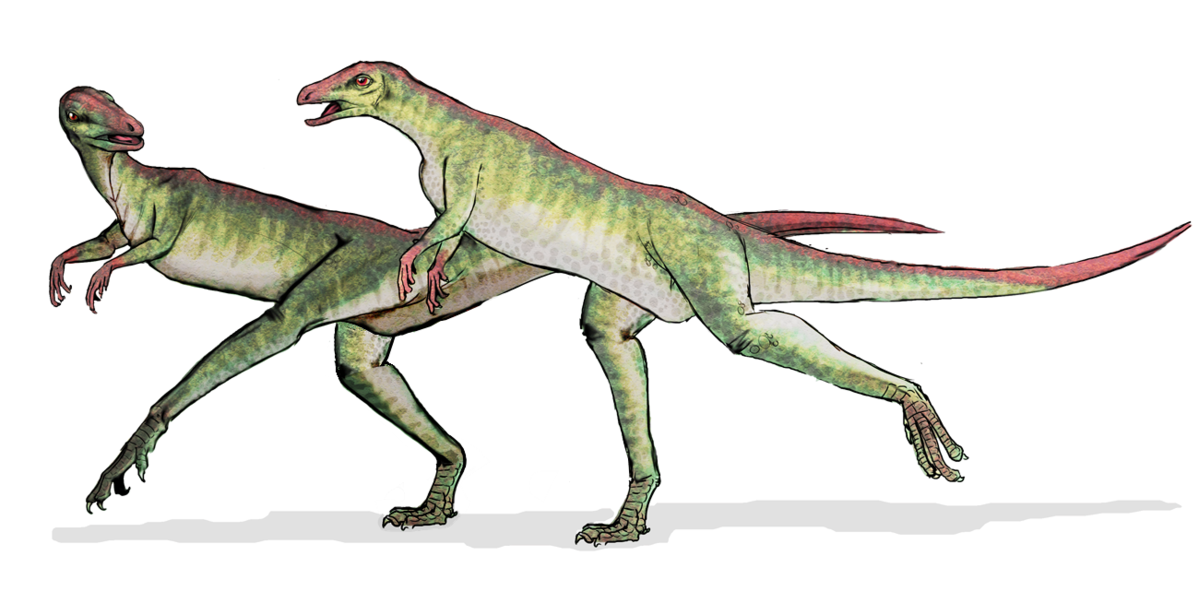
Divergence and convergence not mirror images
- "Species diverge, traits converge"
-
Response to similar environmental constraint, driven by natural selection
- Common ancestor lacks this trait




Discussion activity 2/2 : Convergence
-
You discover 2 new deep-sea fish species. Both are bioluminescent. Close relatives of each lack this trait.
- Explain why close relatives lacking the trait suggests convergent evolution.
- Imagine at least one observation that would be strong evidence against convergent evolution.
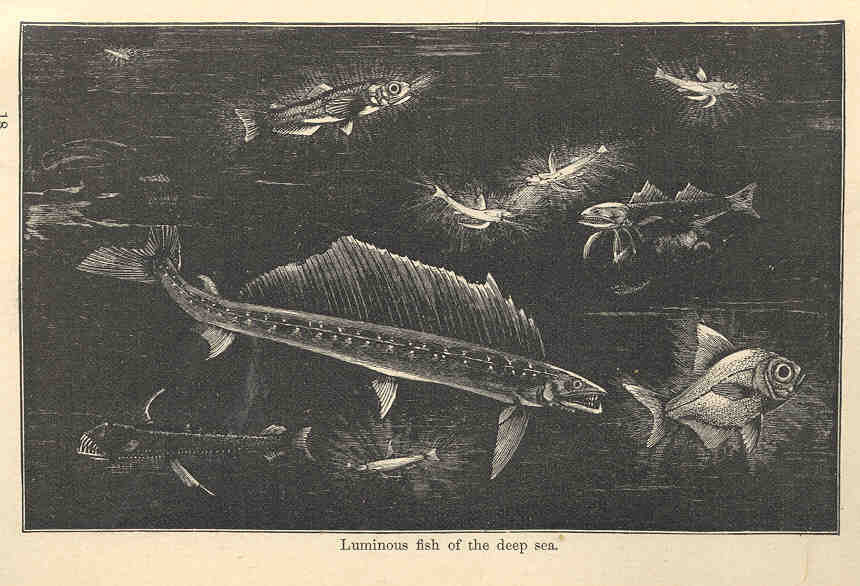
Discussion activity conclusion
-
Convergence answers:
- Many fossils of this group across a long time period.
- Fossils would give an idea of the diversity of traits and how they have changed over time.
- Common ancestor would have some similar "ancestral" traits but lack "derived traits". It would also be older!
-
Divergence answers:
- Provides circumstantial evidence for convergence because traits appear to have evolved recently.
- Many potential answers: e.g. two fish are actually closely related, trait was lost multiple times, or related species actually are bioluminescent.
Learning objectives for review
- Identify convergent/divergent evolution in animals, and compare/contrast the two processes
- Explain how natural selection & constraints (environmental and developmental) drive divergent / convergent evolution and constrain its outcome
- Evaluate whether convergence / divergence (or both) is happening in a given situation

Closing thought
From so simple a beginning endless forms most beautiful . . . have been, and are being, evolved” (Darwin, 1859)
From so simple a beginning limited forms most beautiful . . . have been, and are being, evolved.” (McGhee, 2011)
Citations
- G. R. McGhee, Convergent Evolution: Limited Forms Most Beautiful (2011) https:/doi.org/10.7551/mitpress/9780262016421.001.0001 (May 3, 2021).
- M. A. Nilsson, et al., Tracking Marsupial Evolution Using Archaic Genomic Retroposon Insertions. PLOS Biology 8, e1000436 (2010).
Development diagram: http://phhsbiology.weebly.com
Dinosaur images: Nobu Tamura, Mariana Ruiz Villarreal
Other images: Own work / Wikimedia commons.
Why didn't dragons or centaurs evolve from 4-legged animals?
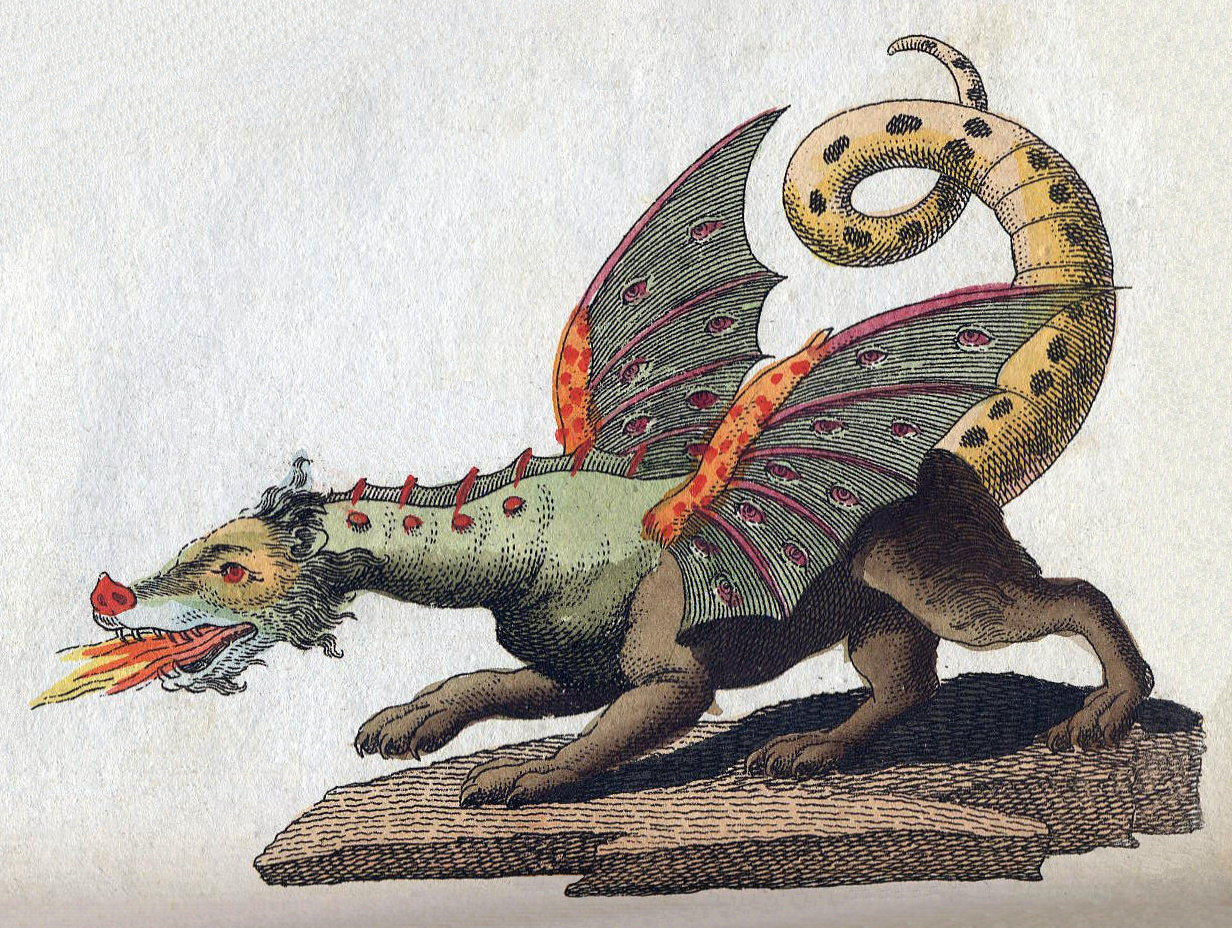

D) Such body plans are developmentally impossible for 4-legged animals
C) Intermediate forms are unlikely to succeed
B) These body plans are not competitive
A) Genes for these body plans don't exist
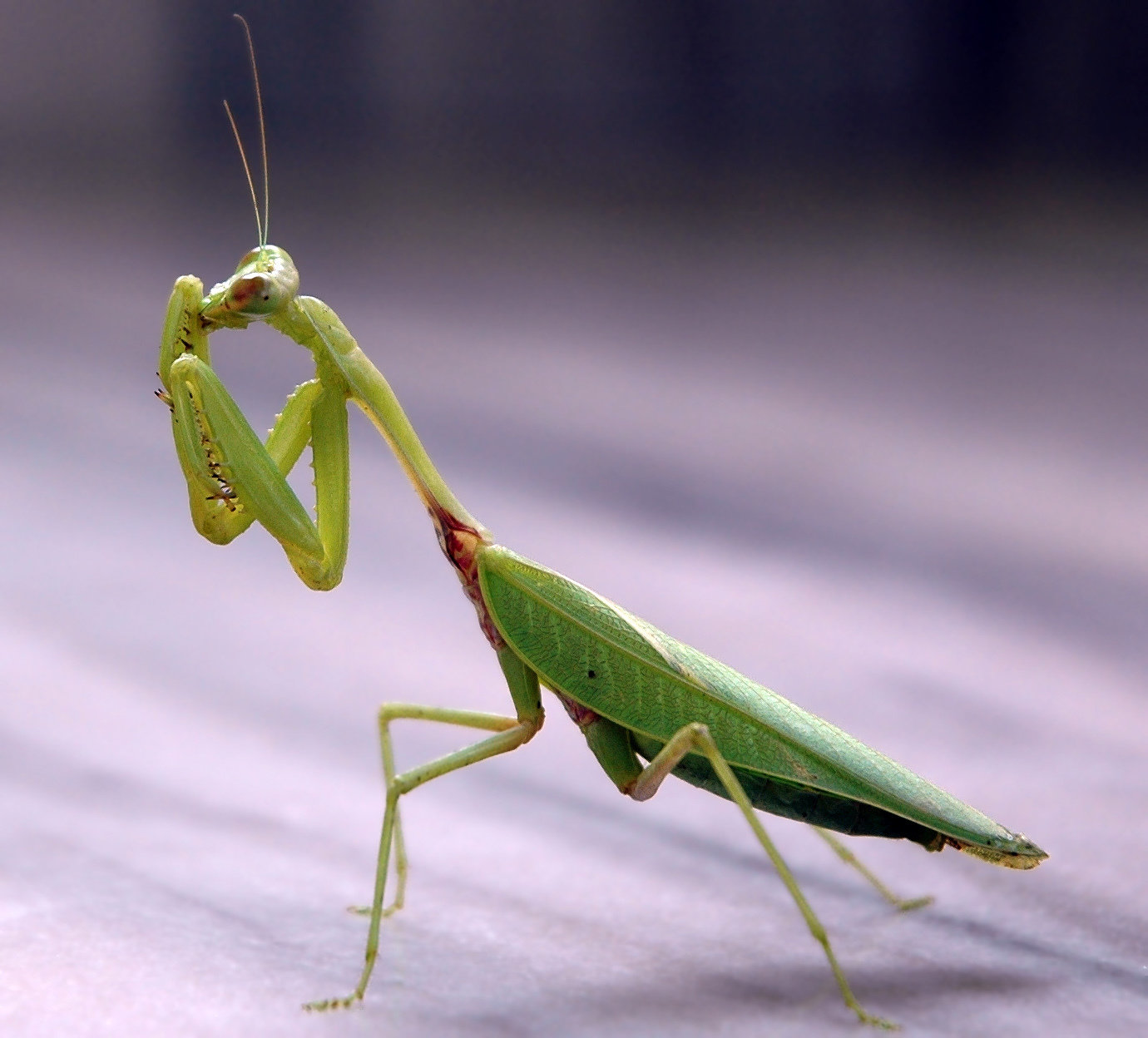
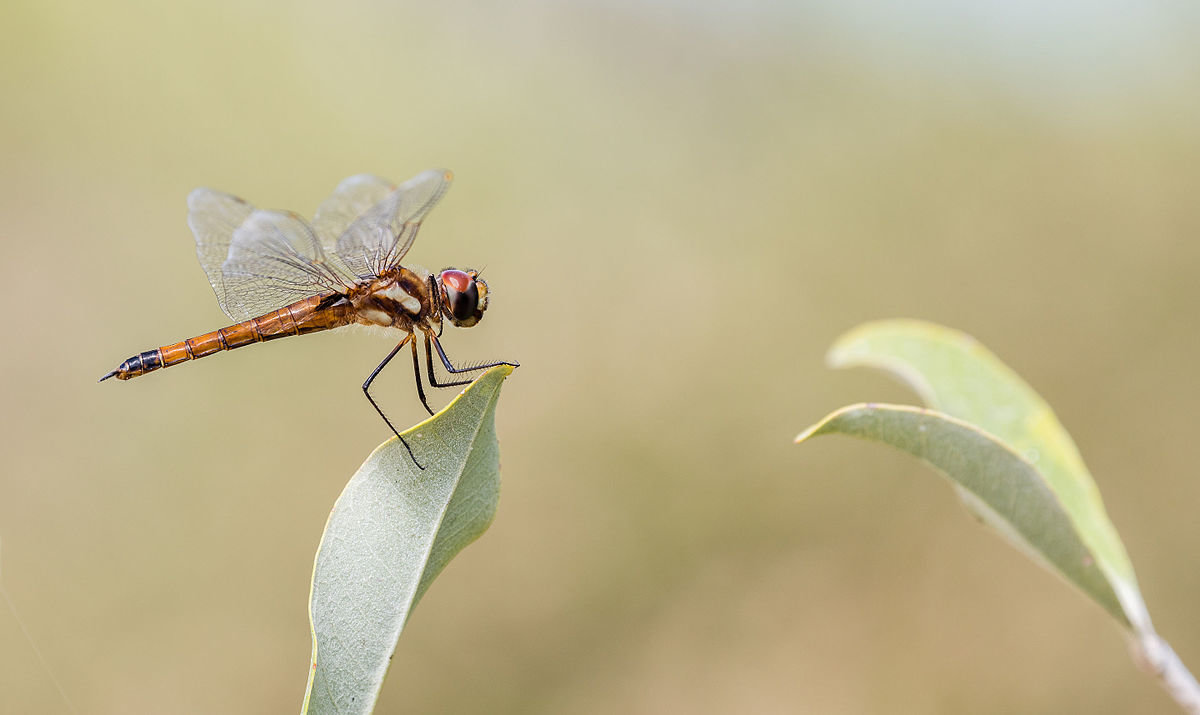
Dragonfly / dragon
Mantis / centaur
Divergence vs. convergence
Marine mammals evolved from a land ancestor but now look a lot like fish. Is this:
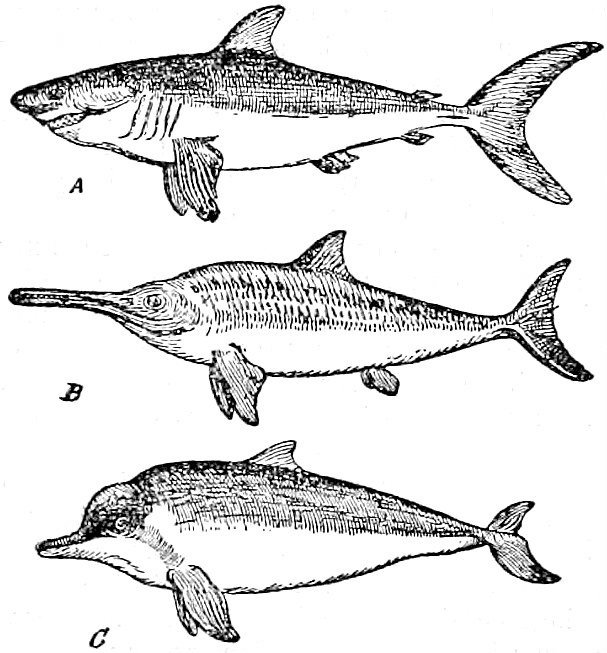
A) A form of divergent evolution
B) A form of convergent evolution
C) A form of both convergent and divergent evolution
D) A form of adaptive radiation but not convergent evolution
Genomes evolve due to speciation
- Changes are "shuffled" or removed by selection
- Genomes diverge by random changes after shuffling blocked
- Future shuffling likely impossible
- Natural selection may be involved but not necessary


Genome size is decoupled from complexity
Note logarithmic scale
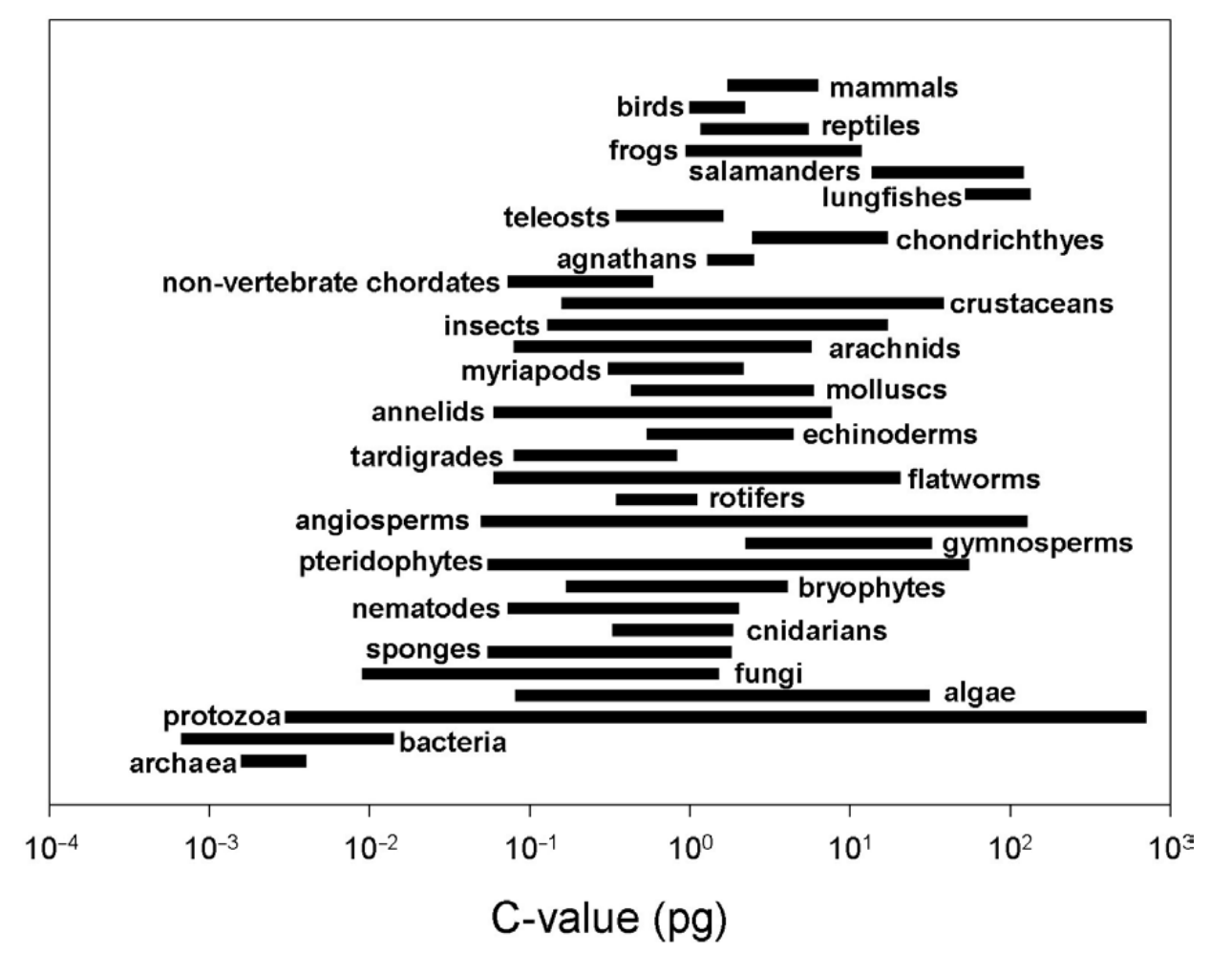
Humans
Genome size: bigger ≠ more complex
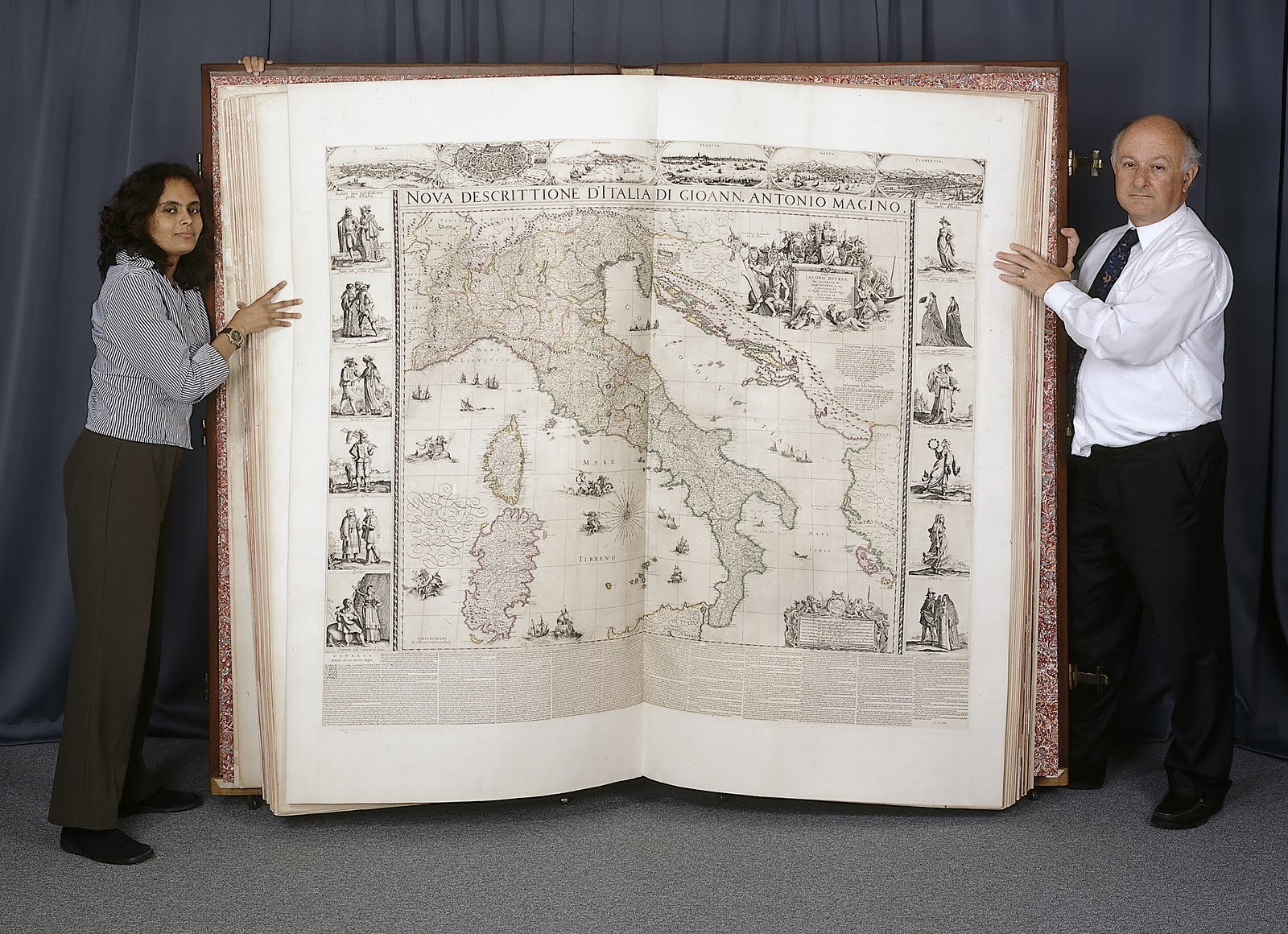
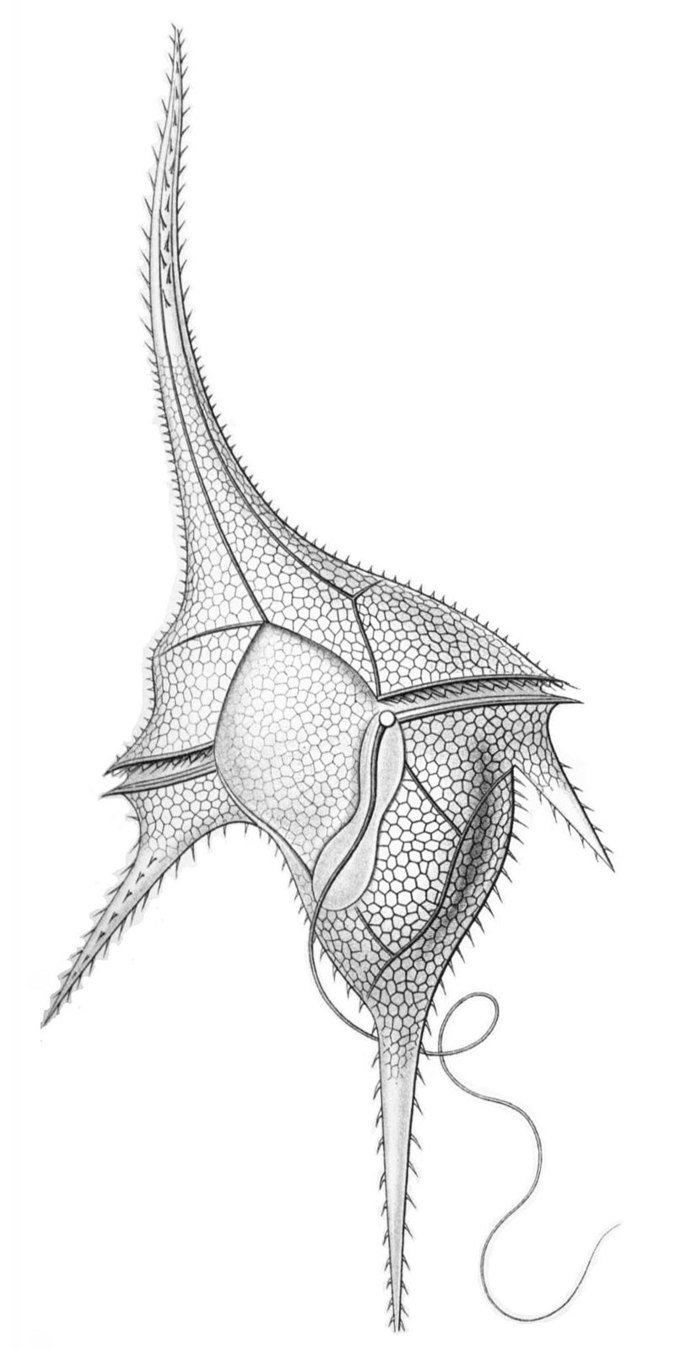
The case of dinoflagellates:
- A group of single-celled algae with genomes 1 - 80x bigger than the human genome!
- Is all this extra DNA just filling up space to make the cell bigger?
Genome size: A quantum leap

Simple prokaryotic genomes
Complex eukaryotic genomes
Genome size evolution
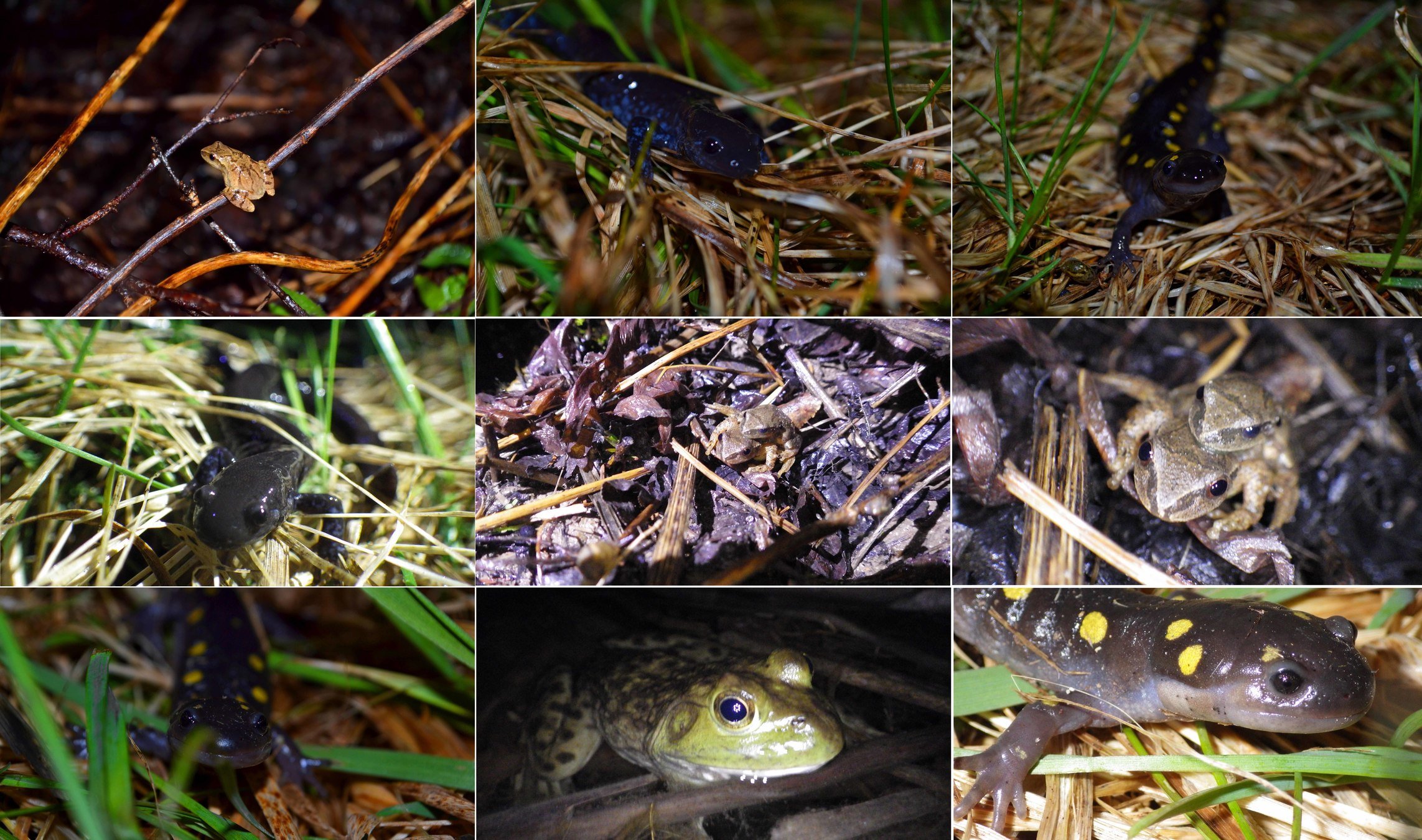



- Bacterial and Archaeal genomes stay within a narrow range
- Endosymbiosis provides power to support genomes at larger scale
Smallest free-living Eukaryote Ostreococcus
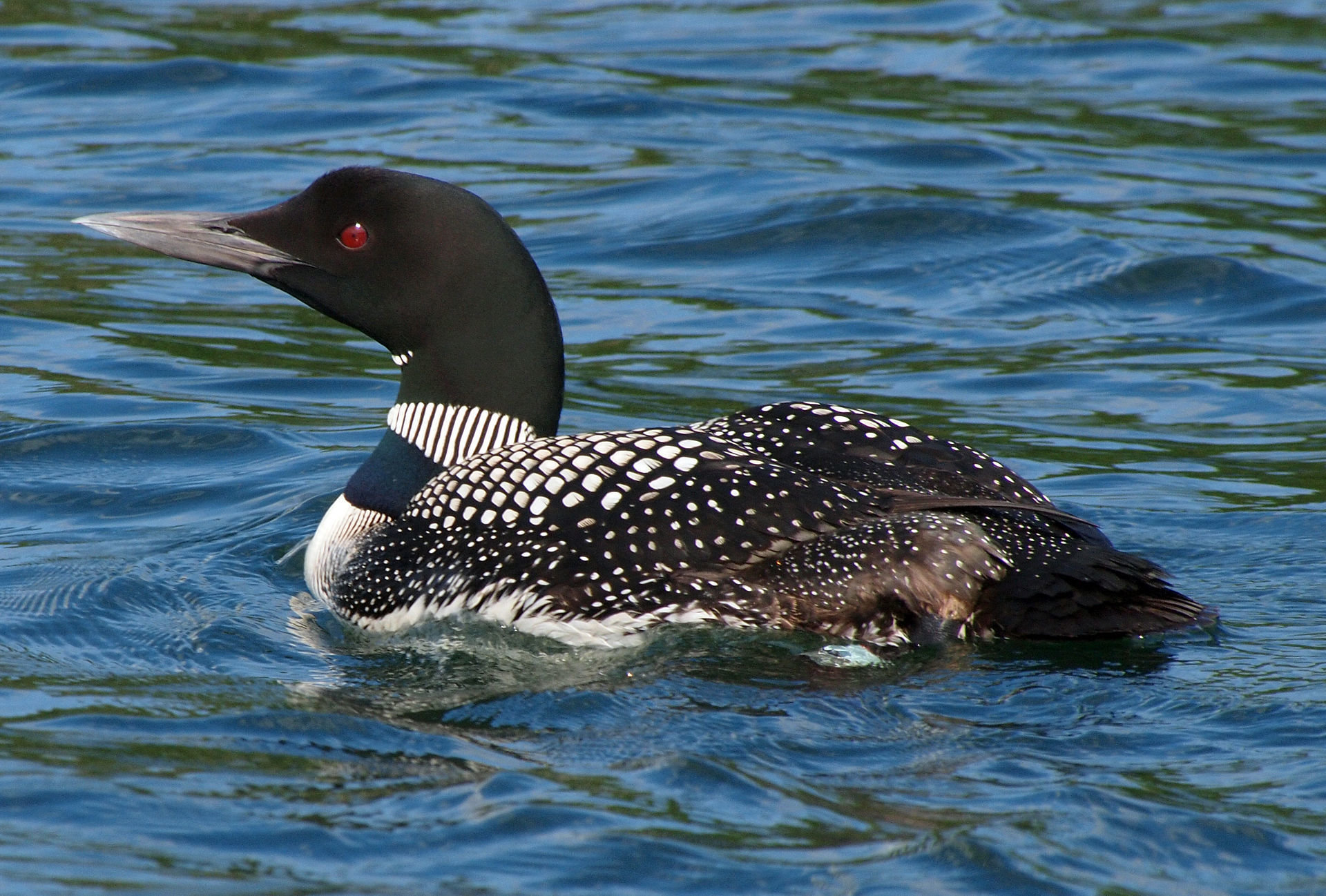
Birds have reduced non-coding DNA
Conclusions
- In a species, individuals "shuffle" genes; new species emerge when "shuffling" is blocked and genomes diverge
- Bacteria / Archaea merger broke "genome size barrier"
- Size could then increase, but is decoupled from complexity
- Streamlining reduces genome size and complexity









References:
Speciation diagram:
- Andrew Z. Colvin (en.wikipedia.org/wiki/User:Azcolvin429)
Genome size diagram:
- T. R. Gregory, “CHAPTER 1 - Genome Size Evolution in Animals” in The Evolution of the Genome, T. R. Gregory, Ed. (Academic Press, 2005), pp. 3–87.
Quickwrites:
- I. J. Leitch, Genome sizes through the ages. Heredity 99, 121–122 (2007).
- P. Ball, Smallest genome clocks in at 182 genes. Nature, news061009-10 (2006).
Other references:
- S. J. Gould, Full House: The Spread of Excellence from Plato to Darwin, Reprint edition (Three Rivers Press, 1997).
-
A. Spang, T. J. G. Ettema, Microbial diversity: The tree of life comes of age. Nat Microbiol 1, 16056 (2016).
-
H. Imachi, et al., Isolation of an archaeon at the prokaryote–eukaryote interface. Nature, 1–7 (2020).
-
S. J. Sibbald, J. M. Archibald, More protist genomes needed. Nature Ecology & Evolution 1, 1–3 (2017).
-
D. Hutchins, Plastic plankton prosper. Nature Climate Change 3, 183–184 (2013).
Other images: Own work / Wikimedia commons / Duckduckgo image search
Next time: Active research
Cheap DNA sequencing => new areas in genome evolution:

Prokaryotes:
- Novel lineages
- Pangenomes


Eukaryotes:
- Huge unsampled diversity
- Non-coding DNA & "function"

Group discussion + worksheet (2o minutes)
In groups of 3-5, discuss the following scenario, fill out the worksheet (2-3 sentences per question in your own words), and hand in by the end of class.
- During fieldwork, you discover two new species that have diverged from a common ancestor. Assuming you have their genomes and can identify coding / non-coding DNA, answer the following questions:
- What other processes other than geographic separation might be responsible?
- One of the two organisms' genomes is much smaller than the other. Assuming their common ancestor had a large genome, what potential factors could explain this difference?
Slides: https://tinyurl.com/genome-evo
- "Lowly" salamanders and liverworts with huge genomes:
- Explain answers
- Highlight student responses
-
Gnome genome: Tiny symbiotic bacteria in sap-feeding insects:
- Explain answers
- Highlight student responses
Review: Quickwrite responses
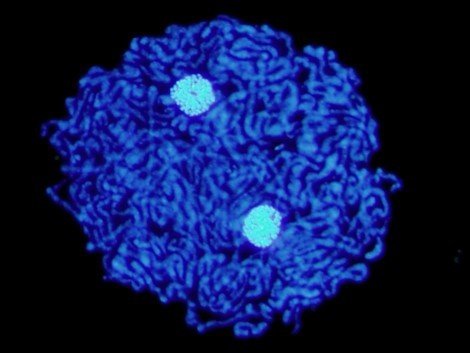

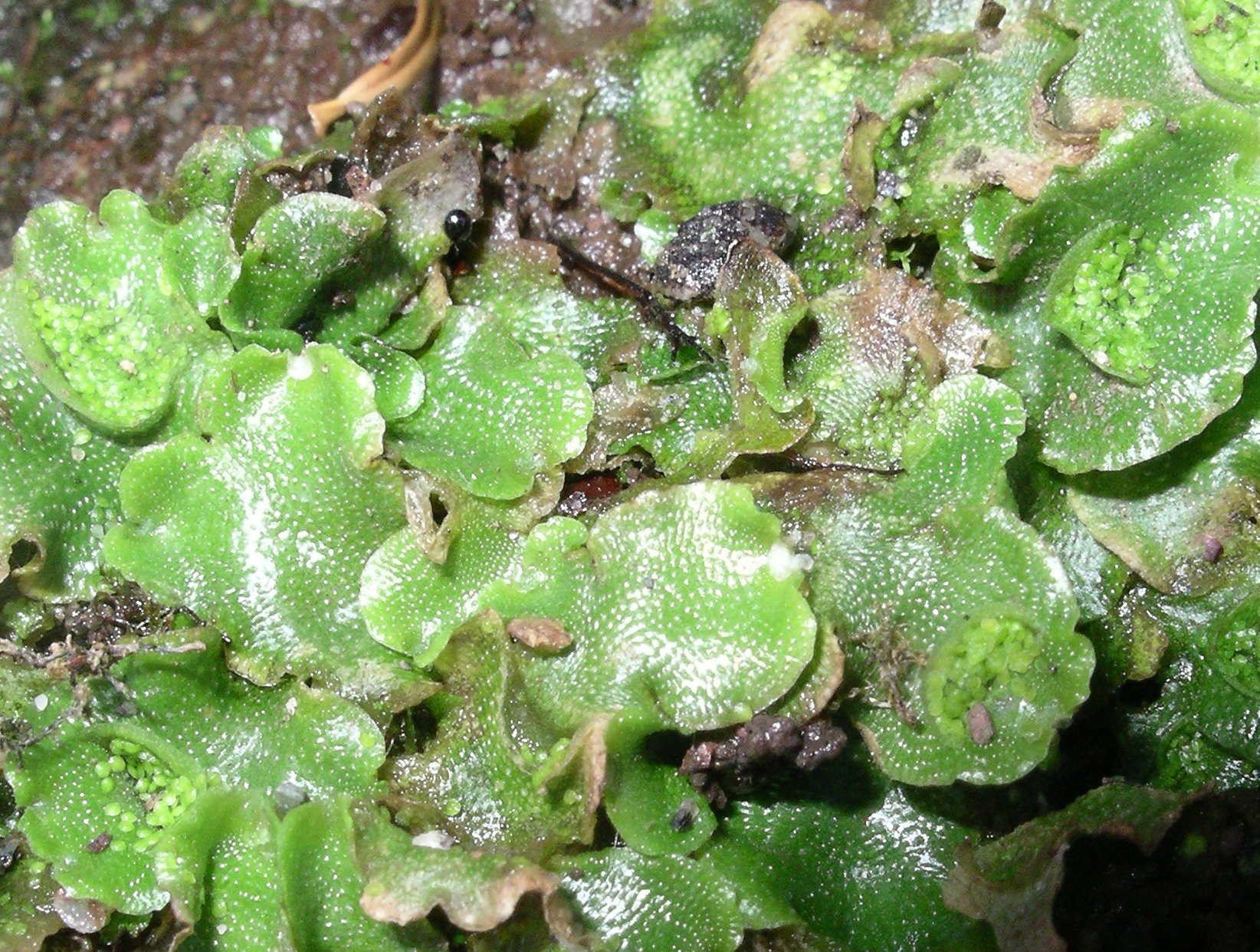
Bishop lab, StFX
References:
Speciation diagram:
- Andrew Z. Colvin (en.wikipedia.org/wiki/User:Azcolvin429)
Genome size diagram:
- T. R. Gregory, “CHAPTER 1 - Genome Size Evolution in Animals” in The Evolution of the Genome, T. R. Gregory, Ed. (Academic Press, 2005), pp. 3–87.
Other references:
-
A. Spang, T. J. G. Ettema, Microbial diversity: The tree of life comes of age. Nat Microbiol 1, 16056 (2016).
-
H. Imachi, et al., Isolation of an archaeon at the prokaryote–eukaryote interface. Nature, 1–7 (2020).
-
S. J. Sibbald, J. M. Archibald, More protist genomes needed. Nature Ecology & Evolution 1, 1–3 (2017).
-
D. Hutchins, Plastic plankton prosper. Nature Climate Change 3, 183–184 (2013).
Other images: Own work / Wikimedia commons / Duckduckgo image search
- A "recipe book" for a cell
- Language of DNA
- Genes code for proteins
- Coding and non-coding DNA
- Genome size varies hugely, even within groups
- Viruses: Tiny - small
- Prokaryotes: Small
- Eukaryotes: Small - gigantic



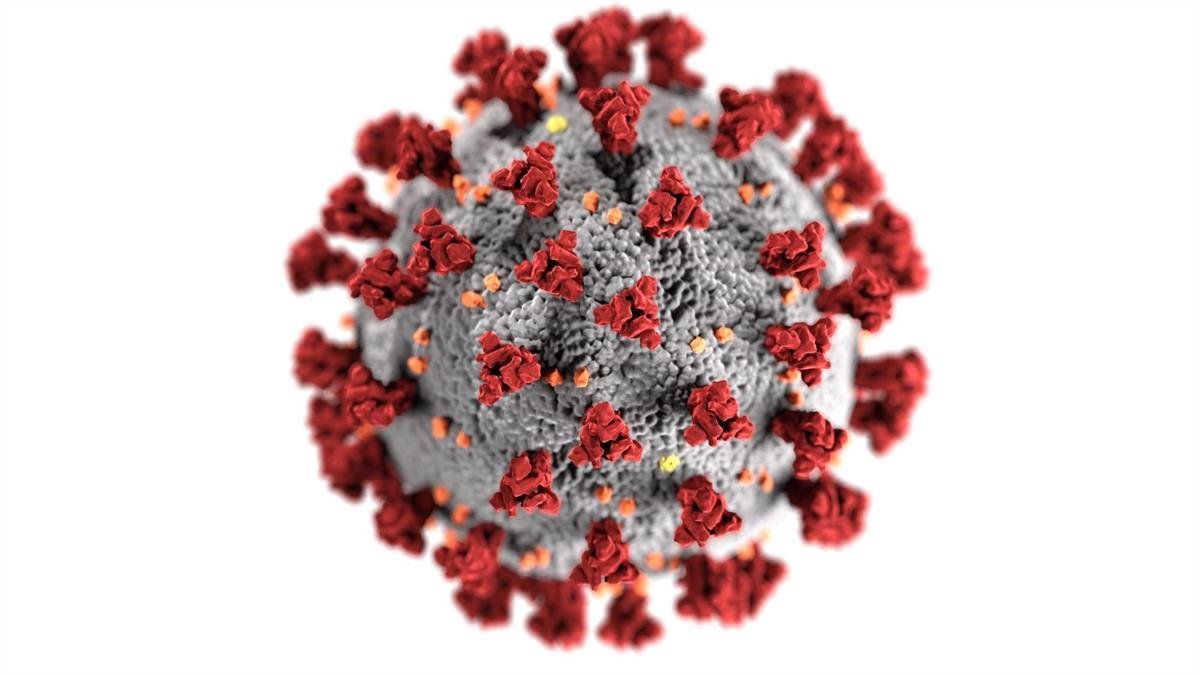


Review: Genome basics
Review: Factors causing genomic change
- Random processes are "raw material" for evolution:
-
Mutation alters DNA sequence
- Neutral, deleterious, or (rarely) advantageous
-
Shuffling mixes gene content:
- "Recombination" between similar sequences
-
Bulking up increases size:
- Duplication (gene / genome)
- Selfish genetic elements
-
Mutation alters DNA sequence
-
Natural selection "acts" on this raw material:
- Either remove or keep changes
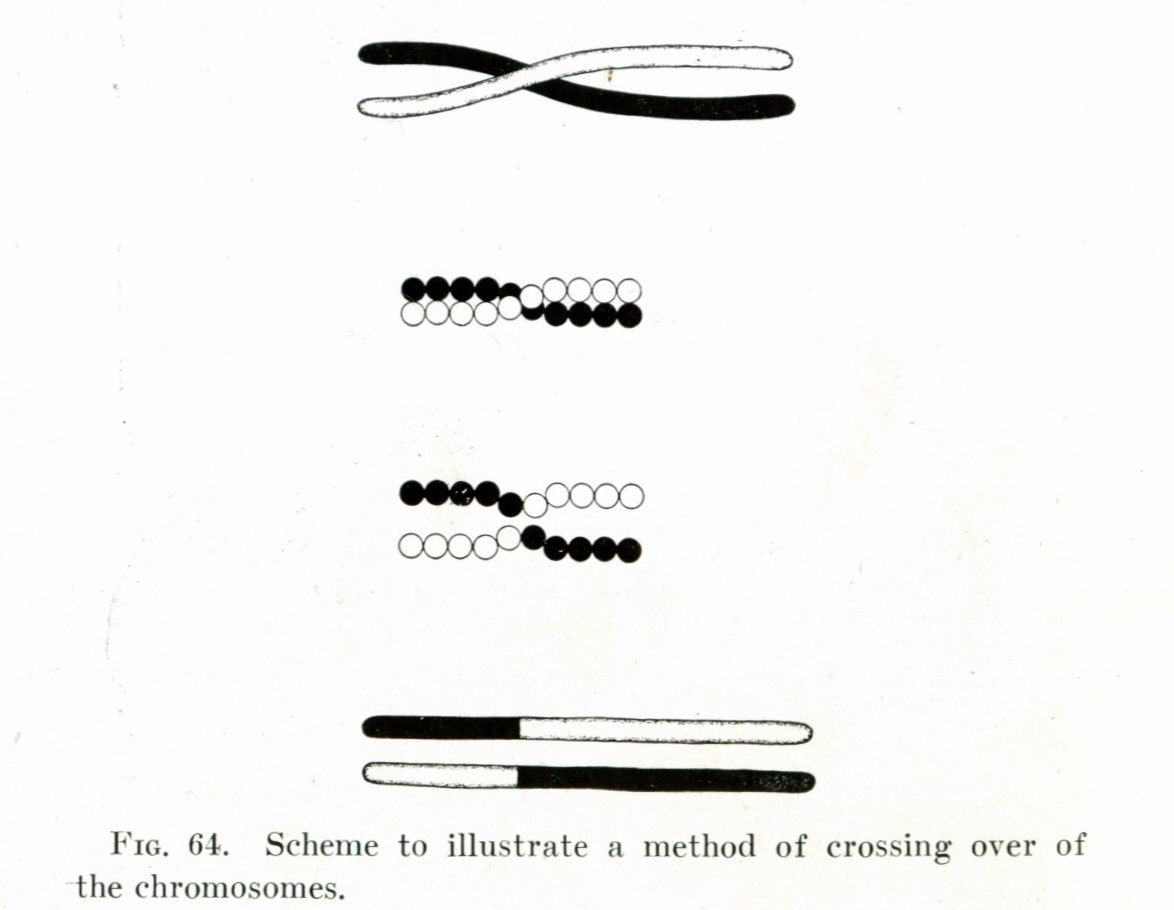


Focus on consequences,
don't worry about exact
mechanisms
Genome evolution and progress

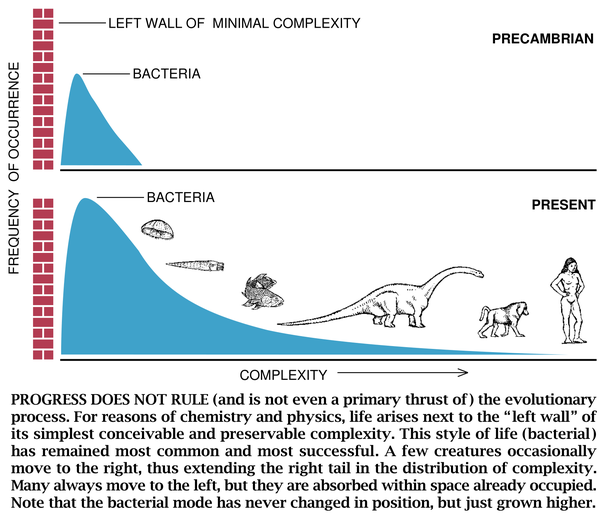
Image credit: Stephen Jay Gould: "Full House"
A two-way street
"quantum leap"

Review: Genome properties
Prokaryotes (small):
- Huge collective metabolic diversity
- High coding density


Eukaryotes (small to huge):
- High morphological diversity
- Low coding density
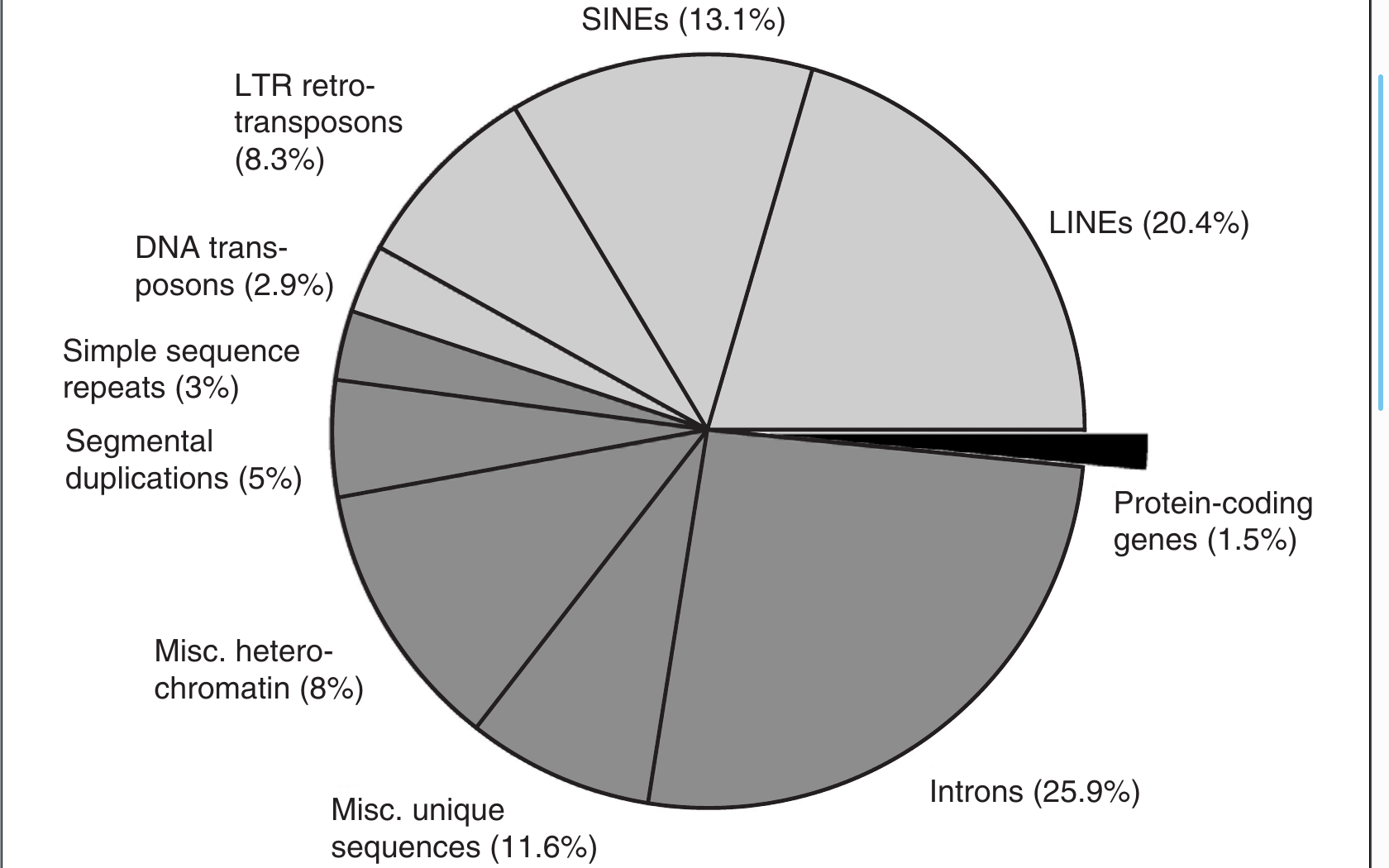


The process of speciation

- Divergence occurs due to factors such as:
- Different resource use (e.g. Darwin's finches)
- Geographic separation
- These are barriers to gene flow, causing species to diverge
Genome evolution at species level
- In a species, individuals "shuffle" genes; new species emerge when "shuffling" is blocked
1. Common ancestor:
- Changes are "shuffled" or removed by selection
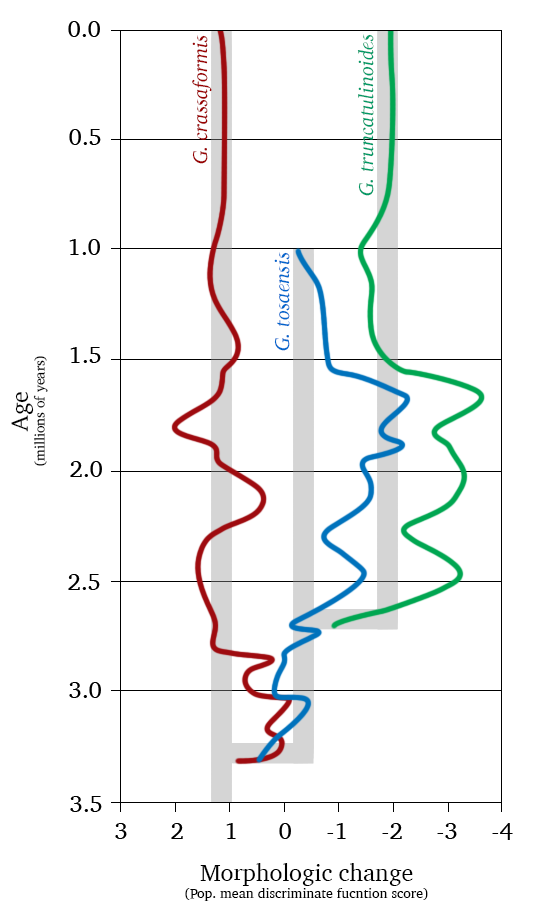
Time (millions of years)
Difference
Modern
Ancient
2. Barrier to gene flow
3. Speciation:
- "Shuffling" blocked
- Genomes diverge by random changes & selection
- Future shuffling impossible
- Natural selection may be involved (not necessarily)
The process of speciation
Prokaryote gene flow:
- Horizontal gene transfer
- Direct exchange of DNA between cells
Eukaryote gene flow:
- Sexual reproduction
- Two organisms merge gametes

- Barriers to gene flow stop genetic "shuffling"
- Without "shuffling", genomes accumulate changes and diverge
Do bigger genomes have more functions?
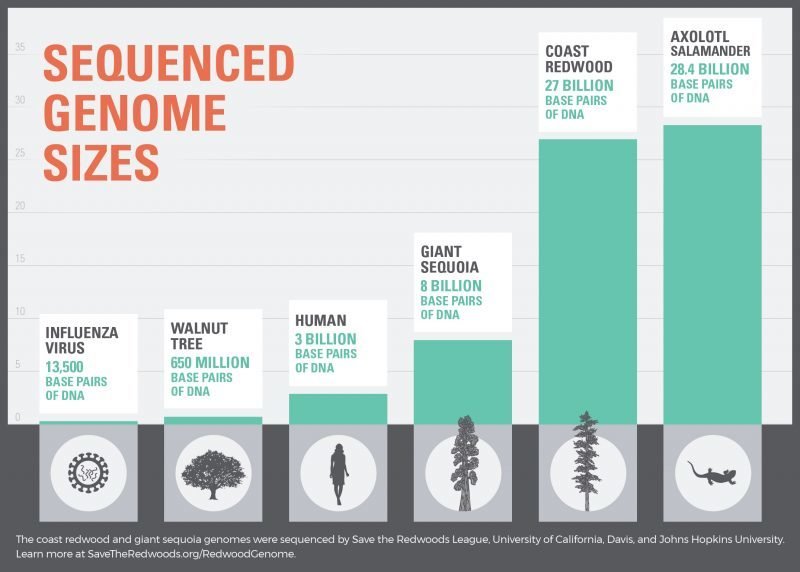


The case of dinoflagellates:
- Single-celled algae; genome size = 3-245 Gb (1 - 80x bigger than the human genome!)
- Just filling up space? Perhaps quite literally...
Oxygen, Ne, and genome size

1. Rise of oxygen
2. Endosymbiosis
3. Animal evolution
O2
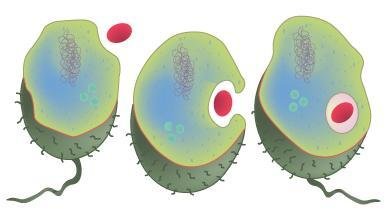
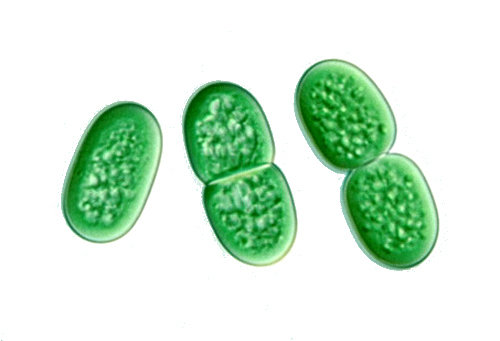
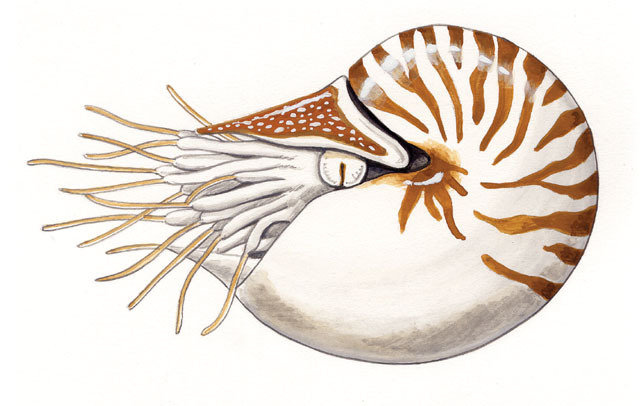
| < 0.001 % current | ~ 1 % current | ~ 100 % current | |
|---|---|---|---|
| ************ | **** | ** | |
| drift | ** | ******** | ************ |
|
size |
* | **** | ********** |
[O2]
Ne
Why did Eukaryote genomes get so big?
- Two general theories:
- Energy: Mitochondria provide more power to support large genomes
- Drift: "Relaxed" selection, allowing expansion through random processes


Evolution "acts" on changes
- If advantageous, may be selected for
- If deleterious, may be "purified"
- If neutral, may be retained
- Function of "effective population size" (Ne)
- High Ne = selection acts efficiently
- Low Ne = selection acts ineffciently
- Neutral / weakly deleterious changes retained
- Leads to "genetic drift"
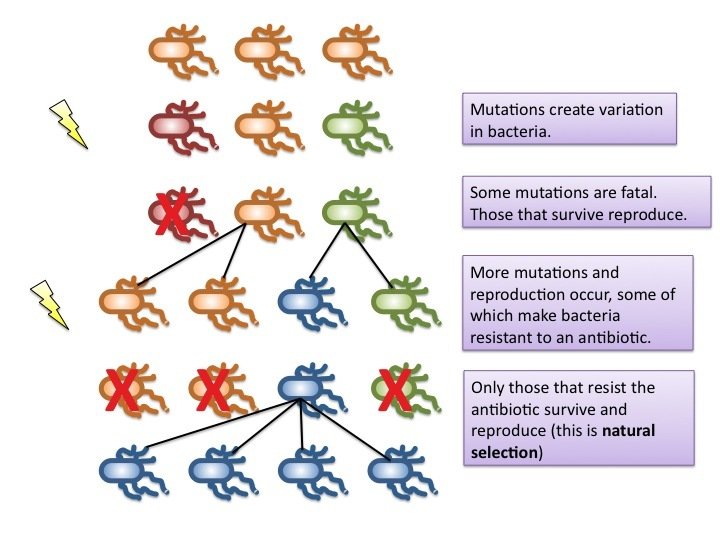
Abdundant, high Ne =
Drift is weak,
selection strong
Rare, low Ne =
Drift is strong, selection weak

Ne (relative scale)
But... this depends on strength of selection:
Evolution "acts" on changes
At the gene level:
- If advantageous, may be selected for
- If deleterious, may be "purified"
- If neutral, may be retained
- Leads to "genetic drift"
At the species level:


StFX Teaching Mini-Lecture, May 17th 2021
By jcmcnch
StFX Teaching Mini-Lecture, May 17th 2021
What is evolutionary divergence and convergence? How are these processes similar and different? How do natural selection and habitat/developmental constraints lead to convergent traits and divergent evolution? How can we identify examples of both? Why have some traits never emerged?
- 41



